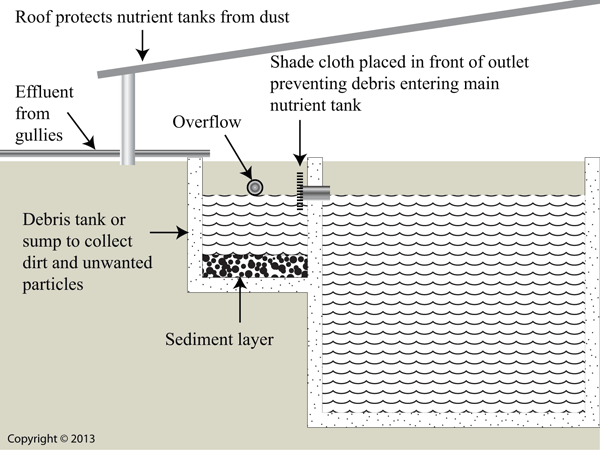Simple method to keep hydroponic NFT nutrient tanks clean
The irrigation water of hydroponic systems must be filtered to keep foreign objects out of the system. Open systems are relatively easy to filter since the water moves in one direction, so it is used only once. With closed systems the situation is entirely different. Not only is the water polluted with organic material from old roots, but it is also further polluted by particles coming of the gravel, organic material from the seedling growth medium, dust that is blown into the system from the soil, precipitation of chemicals and leaves or small objects that float on top of the water. All these objects and particles block the flow of the water in the gravel gullies and irrigation pipes and changes the porosity, texture and flow rate of the growth medium. The cheapest method to filter various foreign objects out of a closed hydroponic system is to install a sump just before the water enters the main nutrient tank (see image below). The sump should at least be 400 mm deep and the outlet should not be closer than 200 mm to the floor of the sump. The outlet opening in the sump should be covered by a removable piece of shade cloth (at least 30 %) to prevent floating objects entering the main nutrient tank. The disadvantage of the shade cloth is it clogs up quite quickly. An easier method is to insert a thin piece of wood or plastic that surrounds the opening. The object must only break the surface water of the sump (maximum depth of 100 mm) and does not have to be very high (maximum 100 mm). Water should be able to flow under the object into the outlet to the main nutrient tank. The advantage of the system is that the outlet cannot be blocked. An overflow should be installed in the sump in case water need to be diverted from the main nutrient tank. This is done in the case of high rainfall periods and the nutrient in the main tank should not be diluted. If the system has a fertilizer injector, the plants will receive continuous strength of nutrients during the rain storm. The disadvantage is that it can become expensive if it rains for a long period. It is a good idea to cover the sump and tank with a roof to prevent dust particles entering the sump. Extend the walls of the sump at least 100 mm – 200 mm above the soil level to prevent run-off water flowing into the sump and nutrient tank. Notice that the sump has an overflow, that is not essential. If you want an overflow, you can also install it higher than the outlet pipe to the main tank. This will ensure that floating debris never reaches the main nutrient tank.

A small 50L tank serves as a dirt collector. No pump is installed in the debris tank. The two are connected with a 110mm PVC pipe fitted with a cloth to prevent floating debris falling into the main tank. This small tank is ideal to sample water for pH and EC.



